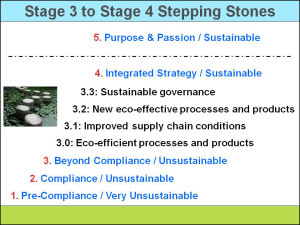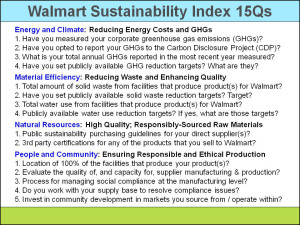It is so important to put a framework around the process, for a business or an individual, of transforming and getting really efficient. This article does a good job on the company side.
Yes, of course, a business can be very sustainable. We've seen it at every size and industry. This is a good start but only a start. The evolution of a company into the green economy takes on-going training, commitment and culture change. Groups like the International Society of Sustainability Professionals has great tools to implement measurements and data collection. Starting with waste and energy use, companies can quickly see social and economic benefits to such changes.
Sustainability – The 4-Step Transformation from Stage 3 to Stage 4
by Bob Willard
Is it really possible for a company to become a sustainable enterprise? Yes, it is. But, it requires a significant transformation. No company will undertake such a significant metamorphosis unless it increases its value. In fact, each step must benefit the company or it will be difficult to convince shareholders and other important stakeholders that it should go further on the sustainability journey.
The four stepping-stones from an unsustainable company to a sustainable business model are designed to ensure that each step produces real business benefits.
In my July 27, 2010, blog, I described the five-stage journey that a business follows—as it moves from an unsustainable enterprise in Stages 1, 2, and 3 to a sustainable enterprise in Stages 4 or 5. In my August 3 blog, we looked at four reasons the current take-make-waste model of business used in Stages 1-3 is not sustainable. In my August 10 blog, we contrasted the take-make-waste model with a sustainable, cyclical, borrow-use-return model of commerce. This week, we will drill down to examine four critical stepping-stones between Stages 3 and 4.
Stage 4 is qualitatively different from Stage 3. Transformations are not trivial. Moving from Stage 3 to 4 requires people and organizations to internalize sustainability notions in profound ways. To facilitate this transformation, corporate sustainability champions should focus on leading their companies through four intermediate steps between Stage 3 and 4: 3.0, 3.1, 3.2 and 3.3.

- Stage 3.0: Eco-efficient processes and productsIn this stage, the firm captures energy, water, materials, and waste handling eco-efficiencies within the company’s current internal operations and processes. Energy efficiencies and waste handling improvements have the biggest payback for most companies, which is why press releases that celebrate eco-efficiency savings always include one or both of these areas. Carbon footprint reductions usually accompany energy reductions, in anticipation of a government-imposed price on carbon emissions. The company’s previously externalized carbon footprint is now internalized within its environmental and societal impacts. The company also increases its engagement with employees and other stakeholders at this step, while improving labor relations. It still produces the same products and services, and uses the same processes; but, it does these more efficiently while passing the savings straight to its bottom line.
- Stage 3.1: Improved supply chain conditionsAcknowledging responsibility for its products’ environmental and social impacts throughout their life cycles, the company implements sustainable procurement practices. It works with suppliers to help them reap the same eco-efficiencies and stakeholder engagement that the company has itself achieved in Step 3.0. Suppliers are encouraged—or coerced—into cleaning up their acts, or else they risk losing the firm as a business-to-business customer.

- Stage 3.2: New eco-effective processes and productsThis is an exciting step. The company re-designs its products and re-engineers its processes to be radically more productive. It co-creates new green products and services with diverse stakeholders. Innovation abounds, spurred on by internal and external creative ideas. The company re-invents itself, providing useful products and services in existing markets and in new, strategic markets. It leases products instead of selling them; so that it can take them back at the end of their useful life and reuse their components and materials, rather than using more expensive, virgin, raw materials. The company saves money because it uses less energy and new material to produce its products. Its employees are more energized, engaged, and productive as they share in the pride of working for a company that is leader in sustainability. Revenue grows as the company captures a larger share of current and new markets. The firm basks in the glow of an enhanced reputation with important stakeholders.
- Stage 3.3: Sustainable governanceThe firm bakes sustainability into its decision-making, its policies, and its culture. The company imbeds sustainability principles into its financial measurement and management systems. It aligns its recognition, reward, evaluation, and remuneration systems to ensure that everyone understands: sustainability considerations are important. They count. Executive teams and boards revamp the company’s governance system to assess—and transparently report on— how the firm is contributing to a sustainable global economy, society, and the environment. This is done while capitalizing on the competitive advantage it has earned from its good reputation.

No comments:
Post a Comment